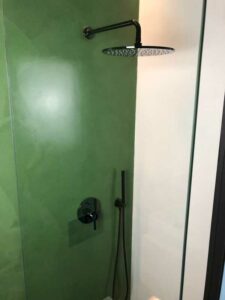
Microcement Price
Microcement Price Microcement Cost What is the price of Microcement? It is the most repeated question lately by many people when they hear about microcement.
We can apply microcement to almost any surface we can think of: plasterboard, tile, brick, tiles, plaster, cement polish, concrete, paints, etc… Thanks to the high adherence of microcement, there will be no peeling problems.
Microcement is the ideal solution to another type of reform that involves expensive, slow, and very dirty works. Microcement, in its approximately 15 years of life, has become the best ally for the renovation of walls and floors, both indoors due to its multiple advantages.
But microcement, being a technical material, needs a series of conditions for its application to be successful. And today we are going to talk about one of those points that can turn our microcement application into a success or failure. And this fundamental pillar is the support where we are going to apply it. It is very important to ensure that the support is in perfect condition, that it is fully consolidated and that it will not come off. The reason is very simple, the microcement is glued to the last layer of the support, therefore, if this is loosened, the microcement will begin to lift from the wall or floor. And the worst thing is that there will be nothing we can do.

The tones that the microcement acquires are due among other factors to its drying speed, hence it acquires the famous waters in its final finish. Well, that drying speed is directly related to the support on which we apply it. Depending on its moisture absorption, the microcement will dry more or less late.
That is why, within the same surface, we cannot have two different supports, since their different drying could cause a sudden change in tone and that it become excessively marked. That is why it must be treated in advance.
At CimentStudio we recommend the application of an epoxy resin that blocks the exchange of moisture, in such a way that the microcement starts from my conditions in both areas.
Another factor that can derail our microcement application is humidity. Moisture can occur for many reasons. One of them is due to not waiting for the drying times of the supports. For example, once the walls have been plastered, if we don’t wait the necessary time for it to dry, that humidity will end up being a problem. Although microcement is waterproof, the retained moisture will eventually detach it from its substrate and cause adhesion problems.
Capillary humidity is another of the possible problems that we can find, especially in low floors. It is strictly necessary to solve this problem before applying microcement. There are a multitude of materials that will help us solve it, materials that repel water that will prevent the microcement from being attacked by moisture.
The application of microcement on tiles is possibly the most common, since it greatly simplifies any type of reform. In this case, from CimentStudio we recommend grouting the tiles with base microcement, and if the joints are large, do it with two coats. In this way we will allow a good curing of the material. Subsequently, the bonding bridge would be applied and the entire process would be applied: base + fine.
If we are going to apply it on a painted wall, it is essential to make sure that the paint is in perfect condition. Keep in mind that with the first layers, we will moisten the surface, so if it is not perfect it is possible that it will end up giving problems.
From CimentStudio we recommend following the established steps and respecting the drying times of all layers. Visit us on our CimentStudio website to learn more about us.

Microcement Price Microcement Cost What is the price of Microcement? It is the most repeated question lately by many people when they hear about microcement.

Microcement Square Meter Price Microcement Square Meter Price What is the price per square meter of the microcement? This is the question that all our

5 Reasons Why Microcement has a Bad Reputation Microcement and its Bad Reputation Nowadays, when we are in the research phase of a reform for